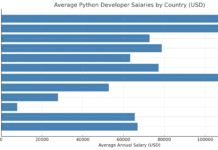Key Takeaways
- B2B eCommerce is growing rapidly, with digital-first purchasing, AI-driven automation, and self-service platforms reshaping the industry.
- B2B marketplaces are expanding, offering businesses greater reach, pricing transparency, and streamlined procurement processes.
- AI, mobile commerce, and data analytics are driving personalization, efficiency, and smarter decision-making in B2B transactions.
The B2B eCommerce landscape is experiencing a rapid transformation, driven by technological advancements, evolving buyer expectations, and the growing demand for digital-first transactions.
As businesses shift towards online procurement and self-service platforms, the global B2B eCommerce market continues to expand at an unprecedented pace.
Industry reports indicate that B2B digital commerce sales have already surpassed trillions of dollars globally, with projections showing sustained growth in the coming years.

This surge is largely influenced by the increasing adoption of AI-driven personalization, automation, and data analytics, all of which are reshaping how businesses engage in trade.
Understanding the latest B2B eCommerce statistics, data, and trends is essential for businesses looking to stay competitive in an increasingly digital marketplace.
Whether it is the rise of mobile commerce, the impact of AI-powered chatbots, or the shift toward marketplace-driven transactions, the latest data provides valuable insights into the future of B2B trade.
With digital transformation becoming a necessity rather than an option, companies that leverage emerging trends can enhance their sales strategies, improve customer experiences, and streamline operations to drive higher revenue.
The ongoing evolution of B2B eCommerce is also influenced by significant changes in buyer behavior.
Today’s business buyers demand seamless, consumer-like experiences that offer personalization, real-time order tracking, and frictionless transactions.
Research shows that a growing percentage of B2B purchases are now completed entirely online, bypassing traditional sales channels.
Additionally, the expansion of AI-powered recommendations, predictive analytics, and automated procurement solutions is accelerating digital adoption across industries, further reinforcing the need for businesses to stay ahead of the curve.
Another key development shaping the industry is the rise of B2B marketplaces.
Platforms such as Amazon Business, Alibaba, and industry-specific marketplaces are revolutionizing the way businesses source products and services.
These marketplaces offer greater transparency, competitive pricing, and enhanced supplier relationships, making them an attractive alternative to traditional sales channels.
Meanwhile, technological innovations such as blockchain for secure transactions, API integrations for seamless connectivity, and AI-driven supply chain optimization are pushing B2B eCommerce toward a more sophisticated and data-driven future.
In this blog, we will explore the top 25 latest B2B eCommerce platform statistics, data, and trends that are shaping the industry in 2024. From market size and revenue growth to emerging technologies and evolving buyer preferences, these insights will help businesses navigate the rapidly changing B2B eCommerce landscape.
By leveraging these key data points, companies can refine their digital strategies, optimize their sales approaches, and capitalize on the growing opportunities within the B2B eCommerce sector.
Before we venture further into this article, we would like to share who we are and what we do.
About 9cv9
9cv9 is a business tech startup based in Singapore and Asia, with a strong presence all over the world.
With over nine years of startup and business experience, and being highly involved in connecting with thousands of companies and startups, the 9cv9 team has listed some important learning points in this overview of the Top 25 Latest B2B eCommerce Platform Statistics, Data & Trends.
If your company needs recruitment and headhunting services to hire top-quality employees, you can use 9cv9 headhunting and recruitment services to hire top talents and candidates. Find out more here, or send over an email to [email protected].
Or just post 1 free job posting here at 9cv9 Hiring Portal in under 10 minutes.
Top 25 Latest B2B eCommerce Platform Statistics, Data & Trends
- Global B2B eCommerce Market Size (2025): The global B2B eCommerce market is projected to reach approximately $32.11 trillion by 2025, reflecting significant growth in digital commerce across industries.
- Projected Growth Rate (2025-2026): Between 2025 and 2026, the B2B eCommerce market is expected to grow at a compound annual growth rate (CAGR) of about 14.5%, driven by technological advancements and changing consumer behaviors.
- Projected Market Size by 2026: By 2026, the global B2B eCommerce market is anticipated to expand to around $36.16 trillion, driven by increased adoption of digital platforms by businesses worldwide.
- B2B eCommerce Market Size in 2019: In 2019, the global B2B eCommerce market was valued at approximately $13.29 trillion, marking a significant baseline for future growth.
- B2B eCommerce Market Size in 2020: The B2B eCommerce market size grew to about $14.87 trillion in 2020, reflecting a modest increase despite the challenges posed by the pandemic.
- B2B eCommerce Market Size in 2021: By 2021, the market had expanded further to around $17.80 trillion, as more businesses began to adopt digital channels for their operations.
- B2B eCommerce Market Size in 2022: In 2022, the global B2B eCommerce market reached approximately $21.01 trillion, highlighting the rapid acceleration of digital commerce in the business-to-business sector.
- B2B eCommerce Market Size in 2023: The market continued its upward trend, reaching about $24.45 trillion in 2023, driven by advancements in technology and increased digital literacy among businesses.
- B2B eCommerce Market Size in 2024: By 2024, the global B2B eCommerce market is projected to be around $28.08 trillion, reflecting ongoing growth and adoption of digital platforms by businesses worldwide.
- Digital B2B Sales Share by 2025: It is estimated that by 2025, digital channels will account for approximately 80% of all B2B sales, underscoring the shift towards online transactions in the business-to-business sector.
- Digital B2B Sales Share in 2019: In 2019, digital channels accounted for about 13% of B2B sales, marking a significant starting point for the rapid growth that followed.
- Revenue from Digital Channels in B2B Organizations by 2025: By 2025, it is projected that digital channels will generate about 56% of the revenue for B2B organizations, highlighting the increasing reliance on digital commerce.
- Revenue from Digital Channels in B2B Organizations in 2020: In 2020, digital channels contributed around 32% to the revenue of B2B organizations, reflecting an early stage in the transition towards digital commerce.
- B2B eCommerce GMV in Europe by 2025: By 2025, the gross merchandise volume (GMV) of B2B eCommerce in Europe is expected to exceed $1.8 trillion, driven by increased digital adoption across the continent.
- B2B eCommerce Market Size in the UK (2022): In 2022, the B2B eCommerce market in the UK was valued at approximately $141.4 billion, reflecting a strong presence of digital commerce in the region.
- Projected B2B eCommerce Market Size in the UK by 2025: By 2025, the UK’s B2B eCommerce market is projected to exceed $167.42 billion, driven by continued growth in digital commerce and technological advancements.
- US B2B Digital Commerce Sales in Q1 2024: In the first quarter of 2024, US B2B digital commerce sales surpassed $358 billion, highlighting the robust growth of digital transactions in the business sector.
- Growth Rate of Cross-Border B2B eCommerce in China (2023): In 2023, the growth rate of cross-border B2B eCommerce in China was approximately 8.2%, reflecting increased international trade and digital connectivity.
- China’s Online B2B Market Size (2023): By 2023, China’s online B2B market had grown to over $1.2 billion, driven by the country’s strong digital infrastructure and trade policies.
- Percentage of B2B Buyers Preferring Self-Service: Approximately 83% of B2B buyers prefer self-service options when making purchasing decisions, indicating a strong preference for autonomy in the buying process.
- Percentage of B2B Buyers Wanting to Self-Serve All or Part of the Buying Journey: A significant 100% of B2B buyers want to self-serve at least part of their buying journey, highlighting the importance of flexible and user-friendly digital platforms.
- Number of Stakeholders Involved in B2B Purchasing Decisions (2024): In 2024, about 41% of businesses reported having two to three stakeholders involved in B2B purchasing decisions, reflecting the complexity and collaboration required in these transactions.
- Percentage of B2B Buyers Trusting Coworkers and Management: Approximately 82% of B2B buyers trust recommendations from coworkers and management, indicating the importance of internal networks in purchasing decisions.
- Percentage of B2B Buyers Trusting Current Vendors: Around 79% of B2B buyers trust their current vendors, highlighting the value of established relationships in business-to-business transactions.
- Percentage of B2B Buyers Trusting Independent Experts: The percentage of B2B buyers trusting independent experts ranges from 66% to 72%, reflecting the importance of objective advice in purchasing decisions.
Conclusion
The B2B eCommerce industry is evolving at an extraordinary pace, driven by the rapid digitization of procurement processes, advancements in AI and automation, and the shifting expectations of modern B2B buyers. The latest statistics and trends clearly indicate that businesses must embrace digital transformation to remain competitive in a marketplace that increasingly prioritizes efficiency, convenience, and data-driven decision-making.
With B2B eCommerce transactions now exceeding trillions of dollars globally, companies that invest in the right digital strategies will be best positioned to capitalize on this growth. The rise of AI-powered personalization, self-service portals, and marketplace-driven transactions underscores the necessity of adopting customer-centric solutions that mirror the seamless experiences found in B2C commerce. Businesses that fail to meet these expectations risk losing market share to competitors that offer streamlined, user-friendly, and highly automated purchasing journeys.
Another critical takeaway from the latest data is the growing reliance on B2B marketplaces. Platforms like Amazon Business, Alibaba, and industry-specific marketplaces are reshaping how organizations procure products and services, offering improved pricing transparency, enhanced supplier networks, and greater operational efficiency. Companies that strategically leverage these platforms can significantly expand their reach, optimize their supply chains, and improve customer engagement.
Additionally, emerging technologies such as blockchain, predictive analytics, and API-driven integrations are revolutionizing how businesses manage transactions, secure data, and facilitate seamless B2B interactions. As digital commerce continues to evolve, the adoption of AI-powered chatbots, automated procurement solutions, and advanced data analytics will become fundamental to enhancing the overall efficiency of B2B sales operations.
The importance of mobile commerce and omnichannel strategies cannot be overlooked either. With an increasing number of business buyers using mobile devices for procurement, companies must ensure that their B2B platforms are optimized for seamless cross-device experiences. Whether through mobile apps, responsive web interfaces, or AI-driven virtual assistants, businesses that prioritize convenience and accessibility will see higher engagement and conversion rates.
Looking ahead, sustainability and ethical sourcing are also becoming key factors influencing B2B purchasing decisions. With heightened awareness around environmental responsibility, companies that adopt sustainable supply chain practices, implement transparent ESG (Environmental, Social, and Governance) policies, and align with green business initiatives will not only meet regulatory requirements but also build trust and long-term loyalty with their partners.
Ultimately, the future of B2B eCommerce lies in digital innovation, strategic automation, and a deep understanding of evolving buyer behaviors. Businesses that stay informed about the latest statistics, trends, and technological advancements will be well-equipped to optimize their digital commerce strategies, drive higher revenues, and build stronger, more resilient customer relationships.
By leveraging the insights from these top 25 latest B2B eCommerce platform statistics, data, and trends, companies can refine their approach to digital commerce, adapt to changing market dynamics, and unlock new growth opportunities in an increasingly digital-first business environment. As B2B eCommerce continues to expand, the organizations that embrace innovation and continuously optimize their digital strategies will gain a significant competitive advantage in the years to come.
If you find this article useful, why not share it with your hiring manager and C-level suite friends and also leave a nice comment below?
We, at the 9cv9 Research Team, strive to bring the latest and most meaningful data, guides, and statistics to your doorstep.
To get access to top-quality guides, click over to 9cv9 Blog.
People Also Ask
What is the current market size of the B2B eCommerce industry?
The global B2B eCommerce market is valued in the trillions, with continued growth driven by digital transformation, automation, and AI-driven solutions.
Why is B2B eCommerce growing rapidly?
B2B eCommerce is expanding due to digital adoption, AI-powered automation, changing buyer expectations, and the demand for self-service purchasing experiences.
What are the latest trends in B2B eCommerce?
Key trends include AI-driven personalization, marketplace expansion, mobile commerce growth, automation in procurement, and blockchain for secure transactions.
How are B2B marketplaces transforming eCommerce?
B2B marketplaces like Amazon Business and Alibaba provide pricing transparency, wider supplier networks, and enhanced digital procurement options.
How does AI impact B2B eCommerce?
AI improves personalization, automates customer interactions, enhances product recommendations, and optimizes supply chain management in B2B eCommerce.
What role does automation play in B2B transactions?
Automation streamlines order processing, inventory management, and customer service, reducing operational costs and improving efficiency in B2B eCommerce.
How is mobile commerce influencing B2B buying?
More B2B buyers use mobile devices for procurement, requiring businesses to optimize their platforms for seamless mobile shopping experiences.
What percentage of B2B transactions occur online?
A growing percentage of B2B transactions now take place online, with many businesses preferring digital self-service options over traditional sales models.
How do self-service platforms benefit B2B buyers?
Self-service platforms allow buyers to browse, compare, and purchase products without interacting with sales reps, enhancing convenience and efficiency.
What is driving digital transformation in B2B eCommerce?
The need for efficiency, data-driven decision-making, and changing buyer behavior is pushing businesses to adopt digital-first B2B sales strategies.
How is predictive analytics improving B2B sales?
Predictive analytics helps businesses forecast demand, personalize marketing efforts, and optimize inventory management for improved sales performance.
What are the top challenges in B2B eCommerce?
Challenges include integrating legacy systems, ensuring cybersecurity, meeting customer expectations, and managing complex pricing structures.
How does blockchain technology impact B2B eCommerce?
Blockchain enhances transaction security, improves transparency, and streamlines supply chain processes in B2B commerce.
Why is omnichannel selling important for B2B businesses?
Omnichannel strategies ensure seamless customer experiences across multiple touchpoints, from websites and mobile apps to social media and marketplaces.
How is personalization shaping B2B eCommerce?
AI-driven personalization tailors product recommendations, pricing, and marketing strategies to individual buyer preferences, boosting sales and engagement.
What industries are leading in B2B eCommerce adoption?
Industries such as manufacturing, wholesale, healthcare, and technology are at the forefront of B2B eCommerce transformation.
How do B2B marketplaces compare to traditional eCommerce websites?
B2B marketplaces offer a wider selection of suppliers, competitive pricing, and streamlined procurement compared to standalone eCommerce websites.
How does AI-powered chatbots improve B2B customer support?
AI chatbots enhance customer interactions by providing instant responses, automating inquiries, and assisting with order processing.
What are the biggest factors influencing B2B buying decisions?
Pricing, product quality, supplier reliability, fast delivery, and digital purchasing convenience play crucial roles in B2B purchasing decisions.
How does data analytics enhance B2B sales strategies?
Data analytics provides insights into customer behavior, sales performance, and market trends, allowing businesses to refine their strategies.
Why is cybersecurity critical for B2B eCommerce?
Cybersecurity protects sensitive business data, prevents fraud, and ensures compliance with industry regulations in B2B transactions.
How does cloud computing benefit B2B eCommerce platforms?
Cloud-based solutions offer scalability, enhanced security, and seamless integration with other business tools, improving operational efficiency.
What is the impact of social commerce on B2B eCommerce?
Social commerce enables businesses to engage customers, generate leads, and drive sales through social media platforms like LinkedIn and Facebook.
What are the advantages of API integrations in B2B eCommerce?
API integrations allow seamless data exchange between platforms, improving efficiency in procurement, inventory, and customer relationship management.
How is sustainability influencing B2B eCommerce trends?
Businesses are prioritizing sustainable sourcing, eco-friendly packaging, and ethical supply chain practices to meet regulatory and consumer demands.
Why is cross-border B2B eCommerce expanding?
Globalization and digitalization enable businesses to access international markets, expand their reach, and grow revenue through cross-border trade.
How do digital payments streamline B2B transactions?
Digital payment solutions reduce transaction times, enhance security, and improve cash flow management for B2B buyers and sellers.
What is the future of AI-driven automation in B2B eCommerce?
AI-driven automation will continue to improve sales forecasting, customer support, procurement processes, and overall business efficiency.
How can businesses prepare for the future of B2B eCommerce?
Companies must invest in digital platforms, AI, automation, and data-driven strategies to stay competitive in the evolving B2B eCommerce landscape.
Sources:
- SellersCommerce
- Shopify
- Forrester
- Statista
- Gartner
- TrustRadius
- Digital Commerce 360
- China Daily






























![Writing A Good CV [6 Tips To Improve Your CV] 6 Tips To Improve Your CV](https://blog.9cv9.com/wp-content/uploads/2020/06/2020-06-02-2-100x70.png)


